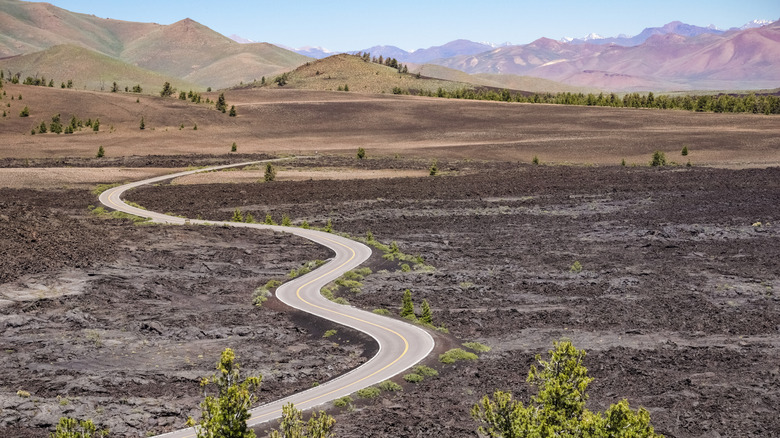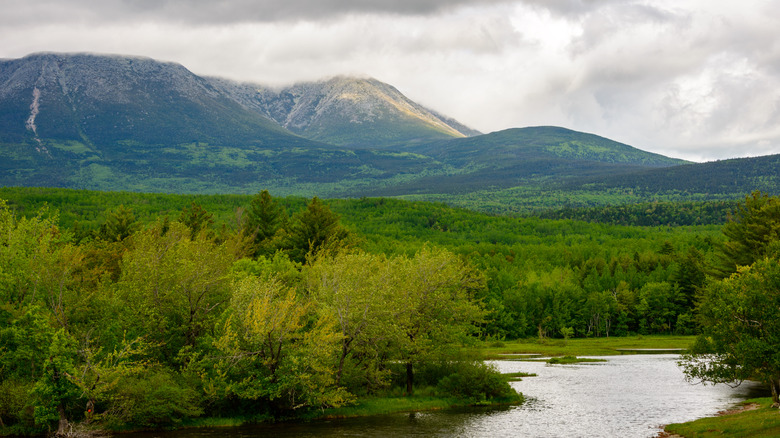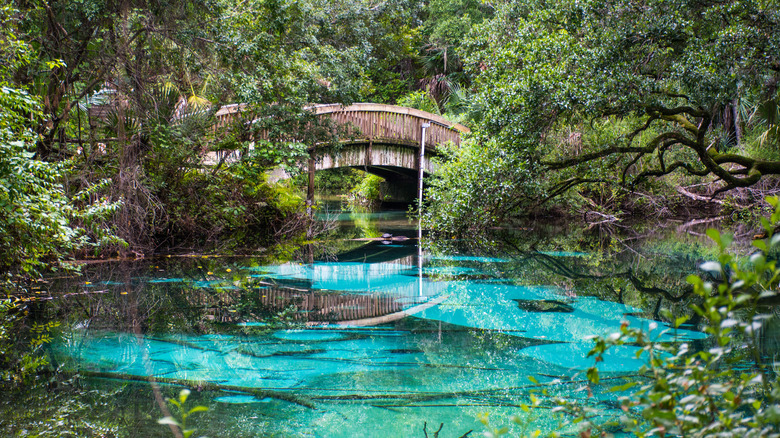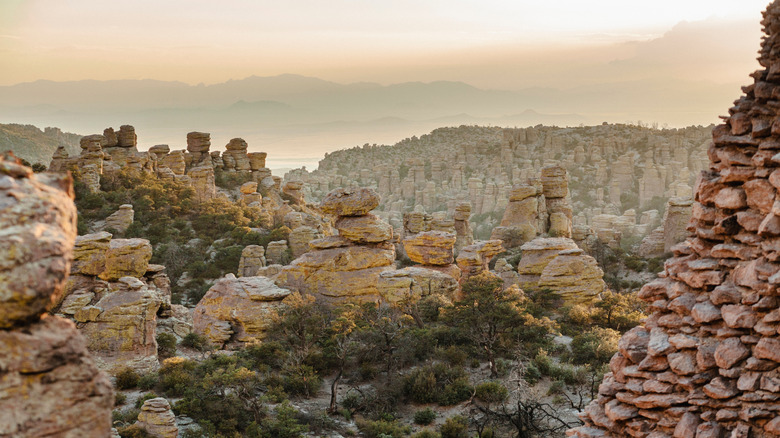5 Forests And Monuments That Are Most Likely To Become America's Next National Park
Since Yellowstone National Park's establishment in 1872, the National Park Service (NPS) has grown to protect 433 sites across the country. The NPS' assets range from one-block historical places to massive wilderness preserves larger than entire countries. However, while the NPS protects everything from national monuments to national historic sites and recreation areas, it's the system's official national parks that draw most of the acclaim. The NPS currently oversees 63 national parks, including both the original Yellowstone and recent additions like Gateway Arch National Park in St. Louis. And while 63 sounds like a lot, the United States has plenty more magnificent public lands that would make fine additions to the prestigious collection of national parks. Several of these spots already have a dedicated base of politicians, conservationists, and local advocates pushing for their establishment as full-on national parks.
As national parks fall under the jurisdiction of the federal government, the creation of a new one lies with Congress. Unfortunately, this means that the national park creation process is subject to the ever-shifting political winds, delays, and partisanship that influence Congress. This makes establishing a new national park seem almost impossible at times. Still, Congress has passed legislation to designate new national parks in the past and could do so again if favorable political circumstances arise. Even better, most of the sites shortlisted as the "next national park" are already federally protected as national monuments or forests. While you can find abundant areas across the U.S. that warrant national park status, these five national monuments and forests may have the best chance of becoming America's 64th national park. These picks are based on current legislative momentum, unique geological or ecological features, and the level of local and federal advocacy already in motion.
Craters of the Moon National Monument & Preserve, Idaho
Even if you've never heard of it, the name "Craters of the Moon" should convey the otherworldly qualities of this underrated Idaho national monument. Though Idaho is not often associated with volcanoes, it does very much have a volcanic past. Craters of the Moon National Monument & Preserve is by far its most impressive volcanic remnant. Between 15,000 and 2,100 years ago, this region of south-central Idaho was blanketed with lava from a series of eruptions. As this lava cooled, it forged one of the most unique landscapes in the United States.
Today, the Craters of the Moon Volcanic Field contains excellent examples of different types of formations. An Oregon State University article lists them as: "cinder cones, spatter cones, lava tubes, volcanic bombs, and tree molds" (molds of trees encased in lava). The black igneous rocks and stark volcanic peaks are still relatively barren, with only a small cover of sagebrush and other plants. The result is Craters of the Moon's weird and surreal landscape that's incredible to explore.
Craters of the Moon's potential as a national park is not merely due to its one-of-a-kind natural scenery. It also offers some of the country's most remarkable outdoor adventures. Its 7-mile Loop Road provides an excellent tour of this volcanic landscape, while wintertime brings in superb snowshoeing and cross-country skiing. You can even get a free permit to explore the park's lava tube caves. Per Oregon Live, local advocates have been petitioning congressional representatives to establish Craters of the Moon as a national park for several years. While these efforts have so far not yielded results, advocacy for the park shows no sign of slowing, so you may be able to visit Craters of the Moon National Park in the near future.
Katahdin Woods & Waters National Monument, Maine
Maine's magical Acadia National Park is well known as a crown jewel of the northeastern coast. However, Maine's landscape is equally magnificent further inland, with stunning displays of northern Appalachians interspersed with enchanting forests and waterways. The epicenter of the state's extraordinary beauty is perhaps the spectacular 5,267-foot Mount Katahdin, Maine's highest mountain and one of the most picturesque peaks of the northeast. Mount Katahdin (also known simply as "Katahdin") sits within Maine's underrated hiking paradise, Baxter State Park. However, right next door is an equally stunning NPS-administered site. And, if legislation comes through, Katahdin Woods and Waters National Monument may be America's next national park.
Katahdin Woods and Waters National Monument protects 87,500 acres of pristine forests and rivers east of Mount Katahdin. Located in north-central Maine, about a 1.5-hour drive north of Bangor, Katahdin Woods and Waters is a ravishing display of the grandeur of Maine's North Woods. Much of the park's forests are part of the East Branch Penobscot River system, one of the least developed watersheds in the country. The park also contains charming examples of wetlands, rivers, and a blend of deciduous and coniferous forests.
The park's remote location also keeps it free of light pollution at night, leading to its designation as an official International Dark Sky destination. And though its namesake mountain is not actually in the park, Katahdin Woods and Waters does provide excellent shots of the famed mountain in profile. Recent legislation has begun expanding the park's borders, which advocates hope will expedite the creation of Katahdin Woods and Waters National Park. While it's not quite there yet, there's no question that Katahdin Woods and Waters has a high chance of becoming a national park in the future.
Ocala National Forest, Florida
Florida currently boasts three of the nation's 63 national parks: the well-known Everglades, the overlooked Dry Tortugas, and the (largely) underwater Biscayne. However, if recently proposed legislation is successful, the Sunshine State may soon have four. Ocala National Forest is a stunning federal preserve between Gainesville and Orlando, protecting a gorgeous display of Florida's subtropical climate and complex blend of wetlands and forests. Aside from being the southernmost in the state, the 441,925-acre Ocala National Forest is also the only national forest in Florida's peninsular region. This unique geography provides Ocala with a distinctive blend of sand pine and longleaf pine forests, as well as lush wetland prairies.
While the park has plenty of natural wonders to share with visitors, Ocala National Forest's most striking feature is arguably its extraordinary collection of springs. In fact, the park's four crystal-clear, naturally-fed springs — Juniper Springs, Salt Springs, Alexander Springs, and Silver Glen Springs — would each be the defining feature of most federal and state parks. These springs are not only beautiful to look at, but they also offer excellent water recreation under the hot Florida sun. The Alexander Springs Recreation Area is known for superb swimming and scuba diving opportunities in the spring's crystalline waters. Meanwhile, the Silver Glen Springs Recreation Area is ideal for kayaking and canoeing near important Native American archeological sites.
Ocala's amazing springs are also the focus of efforts to create a new national park. In 2025, Florida Congressman Randy Fine proposed legislation that would turn Ocala National Forest and a few surrounding springs into the new Florida Springs National Park. While this proposal has so far received mixed reactions from the local community, it is an important step towards Ocala joining the Everglades in the pantheon of American national parks.
Chiricahua National Monument, Arizona
With natural wonders as acclaimed as the Grand Canyon, the Painted Desert, and Monument Valley, Arizona doesn't exactly need an additional national park treasure. Still, beyond the borders of its most iconic sites lie a diverse collection of lesser-known areas that would make excellent additions to America's national park list. Prominent among these is Arizona's astounding Chiricahua National Monument. While most parts of Arizona boast the state's distinctive desert beauty, Chiricahua stands out for its unforgettable display of truly bizarre (yet beautiful) geological features. In fact, with some of the most unique features in the National Park System, Chiricahua has become known as Arizona's "wonderland of rock."
Like Utah's more famous Bryce Canyon National Park, Chiricahua National Monument is packed with eye-catching natural rock formations called hoodoos. Chiricahua's hoodoos take the form of prominent pinnacles — many rising hundreds of feet in the air — often made of a type of volcanic rock called rhyolite. These pillars are the remnants of an ancient volcano that erupted around 27 million years ago. Subsequent epochs of wind and rain erosion carved these volcanic remains into distinctive pillar shapes, creating something of a "forest" of rocky pinnacles that nearly defies belief.
The park's hoodoos are surrounded by prominent slot canyons, natural bridges, and even balanced rocks, while the horizon is dominated by Arizona's spectacular sky islands. There are even historic sites within the park, like the cozy 19th-century Faraway Ranch. Understandably, Chiricahua has been the subject of much "national park" buzz, with proposed legislation in 2016 and 2023 seeking to create Chiricahua National Park. While legislation remains in limbo, Chiricahua National Monument remains a top Arizona destination for hiking, scenic drives, and sublime stargazing among nature's very own sculpture garden.
Shawnee National Forest, Illinois
Illinois is known much more for the vibrant metropolis of Chicago and its status as the Land of Lincoln than for any fantastic natural features. And yet, Illinois' Shawnee National Forest quietly protects vistas that would look right at home in any national park Instagram reel. The forest sits in southern Illinois, far from the skyscrapers of Chicago. Lying between the Ohio and Mississippi Rivers, Shawnee National Forest represents the convergence of five different physiographic areas. This location gives the site an incredible diversity of plant and animal life, as well as geological marvels you wouldn't expect in the Midwest.
Shawnee National Forest's central feature is arguably its divine Garden of the Gods Recreation Area. Like the similarly-named park in Colorado, Shawnee's Garden of the Gods is a dramatic display of prominent rock formations, in this case a "garden" of vast sandstone monoliths sculpted by eons of wind and rain. Shawnee also contains one of the Midwest's loveliest waterfalls at the Burden Falls Wilderness, plus other lush wilderness areas — Bald Knob, Bay Creek, Lusk Creek, Clear Springs, and Panther Den. Each of these spots has its own amazing attractions. For example, Lusk Creek Wilderness protects the epic Lusk Creek Canyon, with prominent sandstone cliffs and panoramic views that rival the more famous canyons out west. Unsurprisingly, Shawnee National Forest also contains national park-worthy hiking trails.
These factors all make Shawnee National Forest a prime candidate to be Illinois' first national park. In recent years, local activists and conservationists have proposed the creation of Shawnee National Park (via Illinois Times). As of 2025, legislation has only gone as far as to add additional protections to the national forest. Still, if Congress ever does create new national parks, Shawnee National Forest may be among the first in line.





